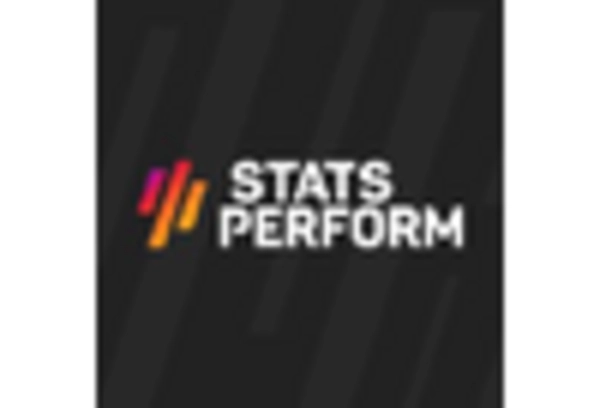Integration of Wearable Technology
The integration of wearable technology is transforming the sports analytics market in Germany, as athletes and teams seek to harness real-time data for performance analysis. Wearables, such as fitness trackers and smart clothing, provide valuable insights into player health and performance metrics. This trend is expected to drive market growth by approximately 30% in the coming years, as teams increasingly adopt these technologies to monitor player conditions and prevent injuries. The data collected from wearables can be analyzed to inform training regimens and game strategies, thereby enhancing overall team performance. As the adoption of wearable technology continues to rise, it is likely to play a pivotal role in shaping the future of the sports analytics market.
Growing Investment in Sports Technology
The sports analytics market in Germany is experiencing a surge in investment as organizations recognize the value of data-driven decision-making. With an estimated growth rate of 25% annually, stakeholders are increasingly allocating budgets towards advanced analytics tools and platforms. This trend is driven by the need for teams to enhance performance, optimize training regimens, and improve overall operational efficiency. As clubs and organizations invest in technology, they are likely to adopt sophisticated analytics solutions that provide insights into player performance, fan engagement, and game strategy. The influx of capital into the sports analytics market is indicative of a broader shift towards embracing technology in sports, which is expected to continue shaping the industry landscape in Germany.
Emergence of Advanced Predictive Analytics
The emergence of advanced predictive analytics is significantly influencing the sports analytics market in Germany. Organizations are increasingly adopting predictive models to forecast player performance, game outcomes, and fan behavior. This trend is expected to contribute to a market growth rate of 18% in the near future, as teams leverage these insights to make informed decisions. Predictive analytics enables sports organizations to anticipate trends and adjust strategies proactively, enhancing their ability to compete effectively. As the technology continues to evolve, the integration of predictive analytics into the sports analytics market is likely to provide teams with a substantial advantage, allowing them to stay ahead of the competition.
Rising Demand for Performance Optimization
In the competitive landscape of sports, the demand for performance optimization is propelling the growth of the sports analytics market in Germany. Teams and athletes are increasingly utilizing data analytics to gain a competitive edge, leading to a projected market expansion of 20% over the next five years. By leveraging analytics, organizations can assess player performance metrics, identify areas for improvement, and tailor training programs accordingly. This focus on performance enhancement not only benefits athletes but also contributes to better team outcomes, thereby attracting more fans and sponsors. As the sports analytics market evolves, the integration of performance optimization tools is likely to become a standard practice among professional sports teams in Germany.
Increased Focus on Data-Driven Decision Making
The sports analytics market in Germany is witnessing a paradigm shift towards data-driven decision making, as organizations recognize the importance of leveraging analytics for strategic planning. This trend is reflected in the growing number of partnerships between sports teams and analytics firms, which aim to enhance operational efficiency and performance outcomes. With an anticipated market growth of 15% over the next few years, the emphasis on data analytics is reshaping how teams approach player recruitment, game strategy, and fan engagement. By utilizing data to inform decisions, organizations can optimize their resources and improve their competitive positioning in the sports landscape. This focus on analytics is likely to become a cornerstone of strategic planning in the sports analytics market.

















Leave a Comment